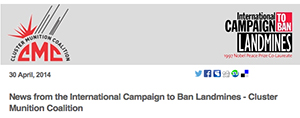08 March 2007
Highlighting Gender in Mine Action on International Women’s Day - Launch of a Global Survey
It is true that men often account for the greatest number of direct victims due the roles that they play, including resettlement activities and agricultural work. Children –especially male children- also represent a very large proportion of landmine and other ERW victims as they often do not recognise the danger that these devices pose. There is growing evidence, however, that it is ultimately women who bear the brunt of the landmine scourge, be it as survivors themselves, or as wives or relatives of those killed or injured by a mine or other ERW.
Female landmine survivors in some countries face immediate divorce as their ability to engage in physical labour and childrearing is considered to be compromised. On the other hand, women are likely to have to care for injured husbands and children, but women may not have access to paid or fairly paid employment. Women may also be deprioiritised for victim assistance where men are considered the typical family breadwinner. Additionally, examination by male doctors may be forbidden and women may be restricted from practicing as doctors.
Failure to consider the significance of gender in the impact of mines and the effectiveness of mine action can lead men, women and children into poverty and destitution. It can mean that vital information is not delivered, or not delivered effectively to ensure the safety of all members of the community.
Priority setting for mine or other ERW clearance can be more effective if all members of the community are consulted and their experiences and perspectives taken into account. Women frequently present clearance priorities that reflect the threat posed to community members in a variety of roles, as well as the threat posed to children.
In Sri Lanka, Cambodia, Kosovo and most recently Lebanon, female deminers have proved themselves highly successful. Global Survey of the Significance of Gender in Mine Action to date, there has been no project to collect comprehensive, global information on the significance of gender in mine action.
In response to this, the Swiss Campaign to Ban Landmines is pleased to announce the launch of a global survey to gather comprehensive information on the significance of gender in the impact of mines and the effectiveness of mine action. The survey targets international mine action organisations; local non-governmental organisations in mine affected territories; relevant government ministries; mine action donors; UN agencies, and; women’s grass roots and civil society organisations. It will collect information on the impact of mines on men, women and children, and on the relevant pillars of mine action: clearance and demining; mine awareness and mine risk education (MRE); victim assistance, and; advocacy for a global ban. The survey questionnaires are currently available in English, and will shortly be available in French and Spanish.
The information gathered through this survey will be synthesised into a toolkit for mainstreaming gender in mine action, aimed at providing all actors within the mine action community and in mine affected territories with detailed and context-specific guidelines. The information will also be used to build the capacity of women’s grass roots and civil society organisations to take part in mine action activities.
For further information please contact Gemma Huckerby, Programme Officer, Gender and Mine Action Programme, g.huckerby@scbl-gender.ch, (+41 22 897 10 52)


